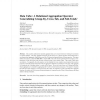Free Online Productivity Tools
i2Speak
i2Symbol
i2OCR
iTex2Img
iWeb2Print
iWeb2Shot
i2Type
iPdf2Split
iPdf2Merge
i2Bopomofo
i2Arabic
i2Style
i2Image
i2PDF
iLatex2Rtf
Sci2ools
CORR
2007
Springer
2007
Springer
Data Cube: A Relational Aggregation Operator Generalizing Group-By, Cross-Tab, and Sub-Totals
Data analysis applications typically aggregate data across many dimensions looking for anomalies or unusual patterns. The SQL aggregate functions and the GROUP BY operator produce zero-dimensional or one-dimensional aggregates. Applications need the N-dimensional generalization of these operators. This paper defines that operator, called the data cube or simply cube. The cube operator generalizes the histogram, crosstabulation, roll-up, drill-down, and sub-total constructs found in most report writers. The novelty is that cubes are relations. Consequently, the cube operator can be imbedded in more complex non-procedural data analysis programs. The cube operator treats each of the N aggregation attributes as a dimension of N-space. The aggregate of a particular set of attribute values is a point in this space. The set of points forms an N-dimensional cube. Super-aggregates are computed by aggregating the N-cube to lower dimensional spaces. This paper (1) explains the cube and roll-up o...
CORR 2007 | Cube | Cube Operator | Education | Operators |
| Added | 13 Dec 2010 |
| Updated | 13 Dec 2010 |
| Type | Journal |
| Year | 2007 |
| Where | CORR |
| Authors | Jim Gray, Surajit Chaudhuri, Adam Bosworth, Andrew Layman, Don Reichart, Murali Venkatrao, Frank Pellow, Hamid Pirahesh |
Comments (0)

